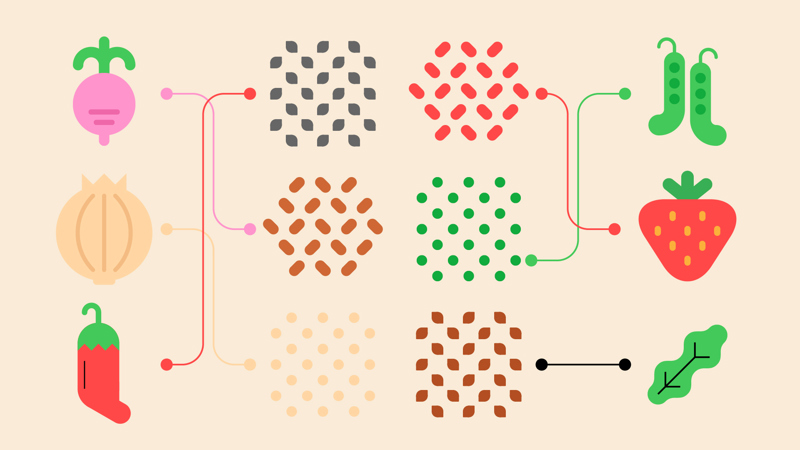
Learn about seasonal food
You’ll need
- Bowls
- Six types of fruits and/or vegetable seeds
- Ripe fruit and vegetables to match the seeds
Before you begin
Make sure you keep a note of which seed is which.
Pips and produce
- Everyone should split into small teams. Give each team six small bowls (each containing one type of seed), and the six matching fruits or vegetables.
- The teams should work out which seeds match which produce.
- Everyone should discuss the produce:
-
- How do you know when these fruits and vegetables are ready to eat? (Foods that are ripe might change colour or become softer to the touch.)
- Does this produce grow in the UK or abroad?
- When during the year might these fruits and vegetables become ready to be harvested and eaten? (Brightly coloured fruits and vegetables will usually be ready to eat in the warmer, sunnier times of year. Fruit or vegetables that do not require the sun or heat as much tend to be harder and darker, and grow earlier or later in the year.)
- When during the year might these fruits and vegetables be sown? Use the 'Sowing and growing' facts below to learn more.
Use nature’s bounty
1. Everyone should carefully save all the seeds.
2. Put the produce to good use by having a taste test or making a smoothie.
Encourage everyone to talk about the steps involved in preparing the produce before it is ready to eat (for example, washing, peeling, or boiling it).
|
Fruit or vegetable |
Sowing season |
Ready to eat |
Approximate growth time |
|
Rocket |
Spring (April to June) |
Summer (June to mid-September) |
Two months |
|
Spinach |
Spring (March to May) Summer (July to September) |
Spring, summer and autumn (March to November) |
Four to six weeks |
|
Radishes |
Spring (March to June) Summer (June to September) |
Spring, summer and autumn (April to October) |
25 to 30 days |
|
Beetroot |
Spring (March to June) Summer (June to July) |
Summer and autumn (June to October) |
30 days for leaves 50 days for root |
|
Green beans |
Spring (April to early July) |
Summer and autumn (June to early October) |
40 to 65 days |
|
Kale |
Spring (April to May) |
Autumn and winter (October to March) |
25 days for baby leaves 50 to 65 days for mature leaves |
|
Spring onions |
Spring (March to June) Autumn (September to October) |
Spring (March to April), summer and autumn (June to October) |
Eight weeks |
|
Potatoes |
Spring (February to May) |
Summer and autumn (June to October) |
Two to four months |
|
Turnips |
Spring (March to June) Summer (June to August) |
Summer and autumn (June to October) |
40 days for greens 60 days for roots |
|
Strawberries |
Winter (January to March) |
Replant in May, harvest in summer (June to September) |
Three weeks to start sprouting |
|
Chillies |
Winter and spring (February to April) |
Summer and autumn (July to October) |
Two to four months |
This guide is for reference only. For more information on seasonal produce, check advice from National Trust or Vegetarian Society.
Reflection
This activity was about learning to live healthily by thinking about where fruit and vegetables come from. Did you learn anything new about the produce that you looked at today? Did anything on the factsheet surprise you – for example, how long it takes certain fruits and vegetables to grow? Why do you think it’s important to eat a varied diet with plenty of fruits and vegetables?
This activity was also about developing practical skills. Why might it be important to know how to grow, harvest and prepare fruits and vegetables? Did you learn anything new about how plants grow from seeds in this activity?
Safety
All activities must be safely managed. You must complete a thorough risk assessment and take appropriate steps to reduce risk. Use the safety checklist to help you plan and risk assess your activity. Always get approval for the activity, and have suitable supervision and an InTouch process.
- Food
Remember to check for allergies, eating problems, fasting or dietary requirements and adjust the recipe as needed. Make sure you’ve suitable areas for storing and preparing food and avoid cross contamination of different foods. Take a look at our guidance on food safety and hygiene.
Discuss the sewing and growing factsheet before trying the activity to make sure everyone has a good basic level of knowledge about how fruits and vegetables grow from seed. Choose unusual produce that the group might not have seen before for more of a challenge.
If you can’t get hold of the grown produce, try using images or plastic fruit instead.
All Scout activities should be inclusive and accessible.
The seeds can be used to complete requirements two and three of this badge.
